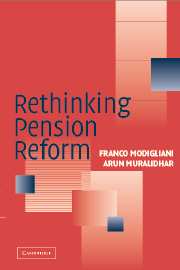Book contents
- Frontmatter
- Contents
- Preface
- Acknowledgments
- A Tribute to Franco
- Rethinking Pension Reform
- 1 A Primer on Pension Reform
- 2 A Taxonomy of Pension Reform Issues
- 3 An Evaluation of Pension Reforms
- 4 Welfare Costs of Defined Contribution Schemes
- 5 The Transition from PAYGO to Funding with a Common Portfolio: Application to the United States
- 6 Social Security Reform in Spain
- 7 The “Two-Pension Fund” Theorem
- 8 The Case for Mixed Systems and Variable Contributions: Improving the Performance of Pension Systems
- References
- Index
7 - The “Two-Pension Fund” Theorem
Published online by Cambridge University Press: 22 August 2009
- Frontmatter
- Contents
- Preface
- Acknowledgments
- A Tribute to Franco
- Rethinking Pension Reform
- 1 A Primer on Pension Reform
- 2 A Taxonomy of Pension Reform Issues
- 3 An Evaluation of Pension Reforms
- 4 Welfare Costs of Defined Contribution Schemes
- 5 The Transition from PAYGO to Funding with a Common Portfolio: Application to the United States
- 6 Social Security Reform in Spain
- 7 The “Two-Pension Fund” Theorem
- 8 The Case for Mixed Systems and Variable Contributions: Improving the Performance of Pension Systems
- References
- Index
Summary
HELPING RETIREES ACHIEVE RETIREMENT OBJECTIVES
The entire pension reform debate and the previous chapters have focused on whether countries that move to funding pension systems should adopt defined benefit (DB) or defined contribution (DC) plans, whether arrangements should be based on individual accounts or pooled arrangements, whether assets should be publicly or privately managed, and whether asset management fees are appropriate or too high. In addition, in the previous chapters we have discussed and debated whether pension systems should be fully funded or partially funded and whether the transition cost is worth bearing and, if so, who should bear it. However, little has been done to help individuals in DC plans, or governments with DB plans, invest monies (in a macro sense) to achieve retirement goals.
Experts urge investors to consider portfolios that (i) are well-diversified, (ii) follow some pattern of asset-risk allocation to reflect the aging of the individual (so-called life-cycle funds), and (iii) choose asset-risk allocations based on an asset-liability analysis (Muralidhar 2001). Regulators in those developing countries where pension reform has leaned toward privately managed DC accounts, have been under pressure to approve equity (domestic or international) investments to allow investors to diversify their portfolios. Even in Japan, regulators had imposed constraints on how funds can be invested (e.g., a minimum of 50 percent in government bonds). These restrictions are now being targeted as the reason for the severe underfunding of corporate pension plans in Japan.
- Type
- Chapter
- Information
- Rethinking Pension Reform , pp. 189 - 203Publisher: Cambridge University PressPrint publication year: 2004



